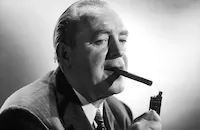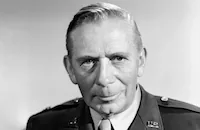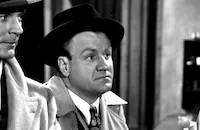The Navy Comes Through

Brief Synopsis
Cast & Crew
A. Edward Sutherland
Pat O'brien
George Murphy
Jane Wyatt
Jackie Cooper
Carl Esmond
Film Details
Technical Specs

Synopsis
At a Navy court of inquiry in Washington, D.C., Chief Gunnersmate Michael Mallory testifies that the negligence of Lieutenant Thomas L. Sands caused a lethal explosion aboard their ship. Protesting his innocence but unable to clear his name, Tom resigns his commission and renounces his sweetheart, nurse Myra Mallory, who happens to be Mike's sister. When war is declared after the bombing of Pearl Harbor, Myra enlists as a Navy nurse, while her brother is given command of a gunnery crew assigned to protect a Merchant Marine ship on its voyage across the Atlantic to Belfast. Tom, who has rejoined the Navy as an enlisted man, is assigned to Mike's crew. Other crew members include Joe "Babe" Dudson, an eager young seaman; Tarriba, a Cuban who feels a debt to the U.S. for liberating his country; Richard "Dutch" Kroner, an Austrian violin virtuoso who is wanted by the Germans; and Berringer, a former boxer. Once they are settled in their quarters, the men begin to gossip about Tom's dubious past. Soon after leaving port, the ship is attacked by a German submarine, and James Bayliss, one of the recruits, is wounded. Because the ship has no medical facilities, the captain signals for a medic from the hospital convoy, and Myra accompanies the doctor on board. As a thick fog spreads, the ship receives a report of a German battleship in nearby waters. With danger imminent, Myra insists upon seeing Tom. Mike delivers her message, but warns Tom that Myra will never be happy until she forgets him. Consequently, when Myra tells Tom that she still loves him, he makes up a story about being in love with someone else. The next day, as Dutch plays a waltz on his violin, German dive bombers attack the ship and Myra is knocked unconscious by some falling debris. Tom leaves his post to carry Myra to safety, but when Berringer, the only man who can attest to Tom's motivation, is killed in the attack, the others accuse him of cowardice and abandoning his post. Soon after the attack, Babe, an amateur shortwave radio operator, unscrambles a German radio message from a submarine on its way to rendezvous with a German supply ship. Mike convinces the captain to intercept the ship, and after the Americans fire a shot across the ship's bow, the Germans surrender. Mike and his crew then board the German ship, but Tom, suspicious of the ease with which the Germans surrendered, cautions Mike to hold the crew on board as insurance. This frightens one of the Germans into confessing that a torpedo has been set to explode. After disarming the torpedo, Mike asks Tom to navigate the ship to Belfast. As an alternative, Mike suggests arming the torpedoes and delivering them to the German subs to detonate. Donning German uniforms, the Americans sink several subs until their ruse is discovered. Attacked by two submarines at once, the American gunners sink one of the boats when the ship's magazine catches fire. After Tom risks his life to pull Mike from the flames, the Merchant Marine ship comes to the rescue and sinks the other submarine. Tom's courage forces Mike to realize that he has misjudged him, and Tom is reinstated as an officer when the ship reaches land. After he and Myra reconcile, Tom says goodbye at the Naval base, and then marches off with Mike on a new mission.

Director
A. Edward Sutherland
Cast

Pat O'brien

George Murphy

Jane Wyatt

Jackie Cooper

Carl Esmond

Max Baer

Desi Arnaz

Ray Collins
Lee Bonnell
Frank Jenks
John Maguire
Frank Fenton
Joey Ray
Marten Lamont
Cyril Ring
Edgar Dearing
Monte Montague
Bud Geary
Malcolm Waite
William Haade
Mary Young
Joe Cunningham

Ralph Dunn

Lyle Latell
Max Waizman
Stanley Andrews
Joseph Girard

Robert Stevenson
William Vaughn

Helmut Dantine
Egon Brecher
Sigurd Tor
Howard Lane
Fred Sweeney
Hans Schumm

Hans Von Twardowski
George Blagoi
Nick Vehr
Jack Martin
Sven Borg
George Melford
Russell Hoyt
Crew
Islin Auster
C. Bakaleinikoff
Earl Baldwin
Samuel E. Beetley
Roy Chanslor
Carroll Clark
Albert D'agostino
Bailey Fesler
Edward Killy
Aeneas Mackenzie
Harley Miller
Nicholas Musuraca
Capt. James A. Randall
Renie
Darrell Silvera
John Twist
Vernon L. Walker
Roy Webb

Videos
Movie Clip




Film Details
Technical Specs

Award Nominations
Best Special Effects
Articles
The Navy Comes Through
The story takes place almost entirely aboard a ramshackle Merchant Marine freighter put into service destroying Nazi bombers and U-Boats (submarines). The crowning glory for the intrepid vessel and its crew is the capture of a German supply ship that they then use against its own navy. There's also a romantic subplot concerning the rocky relationship of one of the crew members with a Navy nurse, who happens to be the sister of the commander of the gunnery team assigned to protect the ship on its trans-Atlantic voyage. The characters are the collection of types typical of such tales, including stalwart skipper Ray Collins, gunnery commander Pat O'Brien, and a crew that includes Desi Arnaz in one of his earliest roles, former child star Jackie Cooper (appropriately named "Babe"), former heavyweight boxing champ Max Baer (father of the future Jethro of TV's Beverly Hillbillies), and hoofer and future U.S. Senator George Murphy as the nurse's beau, Sands, who must redeem himself after being falsely accused of cowardice (a fairly common plot device in many military-based pictures of the time).
The screenplay for The Navy Comes Through was based on "Pay to Learn," a story by Borden Chase, better known for his contributions to such classic Westerns as Red River (1948) and The Far Country (1954). Chase's serialized short story was the only one ever to be published twice in the Saturday Evening Post.
The film also has some other firsts to its credit. Up to this point, the trademark radio tower in the opening logo of producing studio RKO signaled the studio name. With this release, the studio changed its coded beeps to spell out "victory." Another landmark was the use of a special sky and horizon machine created for this film by art directors Carroll Clark and Albert D'Agostino. The device was developed to simulate the effect of water motion against the horizon. A trade paper article at the time noted that the sea shots were filmed on land using rocking arc lamps that projected waves upon an acre of muslin. The same publication added that the guns in the film were built from junkyard materials.
According to pre-production news items in the Hollywood Reporter, Eddie Albert was originally set to play Sands until a scheduling conflict interfered. The role was then assigned to Randolph Scott and eventually to Murphy. Another item in the same paper listed Robert Stevenson as the director. The picture was ultimately helmed by A. Edward Sutherland, who ironically started his career with a silent called Coming Through (1925). Sutherland was also known for directing such comedies as W. C. Fields' Tillie's Punctured Romance (1928), Mae West's Every Day's a Holiday (1937), and Laurel and Hardy's The Flying Deuces (1939).
The picture's working titles were "Pay to Learn" and "Battle Stations." The opening credits feature this foreword: "The Navy comes through has been such an established fact that it is now taken for granted. As a result, we do not realize that the backbone of the Navy is not ships, planes and submarines - BUT MEN."
The Navy Comes Through was premiered on Navy Day at the Treasure Island Naval Base in San Francisco. It earned an Academy Award nomination for Best Special Effects for Vernon L. Walker (photographic) and James G. Stewart (sound).
Although not so favorably reviewed and overshadowed through the years by more ambitious and accomplished combat films, The Navy Comes Through remained a popular story throughout the war years. It was dramatized on the government-sponsored radio series Anchors Away in January 1943 with the part of Sands played by Henry Fonda, who was in the Navy at the time. O'Brien and Murphy returned to their roles for a May 1943 broadcast of the story on Lux Radio Theatre, and O'Brien played it once again for a return broadcast on Lux that November.
Director: A. Edward Sutherland
Producer: Islin Auster
Screenplay: Roy Chanslor, Aeneas MacKenzie; adaptation by Earl Baldwin and John Twist; based on a story by Borden Chase
Cinematography: Nicholas Musuraca
Editing: Samuel E. Beetley
Art Direction: Carroll Clark, Albert D'Agostino
Original Music: Roy Webb
Cast: Pat O'Brien (Mallory), George Murphy (Sands), Jane Wyatt (Myra), Jackie Cooper (Babe), Desi Arnaz (Tarriba), Max Baer (Berringer).
BW-82m.
by Rob Nixon

The Navy Comes Through
Quotes
Trivia
Notes
The working titles of this film were Pay to Learn and Battle Stations. The opening credits feature a foreword that reads: "The Navy comes through has been such an established fact that it is now taken for granted. As a result, we do not realize that the backbone of the Navy is not ships, planes and submarines-BUT MEN." According to the Daily Variety review, Borden Chase's short story "Pay to Learn" was the only story ever to be published twice by Saturday Evening Post. A Hollywood Reporter news item notes that this production marked the studio's first use of a new radio signal trademark that spelled out the word "victory." Prior to this, the studio's radio signal trademark spelled out "RKO."
According to pre-production news items in Hollywood Reporter, Eddie Albert was slated for the role of "Thomas Sands" until a scheduling conflict prevented his appearance. The role was then assigned to Randolph Scott, who was later replaced by George Murphy. Another pre-production news item in Hollywood Reporter credits Robert Stevenson as director. This picture marked Islin Auster's debut as a RKO producer and Lee Bonnell's last appearance before joining the Coast Guard. News items in Hollywood Reporter note that art director Carroll Clark and Albert D'Agostino developed a special sky and horizon machine for this film that created the effect of water motion against the horizon. The Hollywood Citizen-News adds that the sea shots were filmed on land using rocking arc lamps that projected waves upon an acre of muslin. The guns in the film were built from junkyard materials, according to Hollywood Citizen-News. The film's world premiere was held on Navy Day at the Treasure Island Naval Base in San Francisco, CA. This picture received an Academy Award nomination for Best Special Effects. In January 1943, the story was dramatized on "Anchors Away," a government-sponsored radio program broadcast over the Mutual Network. Henry Fonda, who was in the Navy at the time, played the part of Thomas Sands in that production. Pat O'Brien and George Murphy reprised their roles in a Lux Radio Theatre broadcast on May 3, 1943, and O'Brien played his role again in a second Lux broadcast on November 29, 1943.














